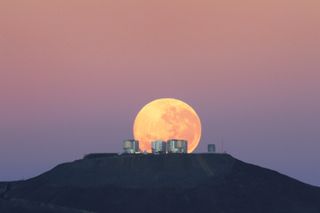Bright Idea or Shady Scheme? Cosmetic Company Wants to Lighten Moon

Geoengineering schemes, even serious ones, often seem a little wacky. But the latest tops them all: a pitch by a cosmetics company to brighten the surface of the moon.
No, they don't plan to slather on a little concealer. According to the company's think-tank Foreo Institute, the idea is to use materials already on the moon to lighten its surface. The goal is to reflect slightly more sunlight onto Earth, making the night sky brighter. A brighter night sky would mean less need for streetlights, which could potentially translate to less electricity usage and thus fewer globe-warming carbon emissions, company representatives say.
"We want to raise public awareness about the project and generate consciousness about the global energy crisis," said Paul Peros, CEO of Foreo.
The proposal has a hint of "marketing scheme" to it, but precisely why the Sweden-based cosmetics company came up with this idea remains unclear. When asked, a company representative told Live Science that Foreo is an "innovation company" that engages with experts from diverse fields. Nevertheless, scientists are skeptical.

"Making the moon brighter is not something I've ever heard of in the geoengineering literature," said Ben Kravitz, a postdoctoral researcher in the atmospheric sciences and global change division of Pacific Northwest National Laboratory. [The Top 10 Craziest Environmental Ideas]
Shoot for the moon
The moon does have subtle effects on Earth's climate. Its gravitational pull creates the tides, which affect ocean currents, astrophysicist Bernard Foing wrote in a 2007 article for Astrobiology Magazine. Ocean currents, in turn, affect weather patterns. An example of influential ocean currents is the El Niño effect, which brings warm and dry winter weather to the northwest United States and wet winters to the Southwest and southern California. [The 10 Most Amazing Facts About the Moon]
Sign up for the Live Science daily newsletter now
Get the world’s most fascinating discoveries delivered straight to your inbox.
But the moon's effect on climate change is negligible, Kravitz said. Even a full moon's brightness is no match for the brightness of the sun: You'd need nearly 400,000 full moons in the sky to match the brightness of Earth's sun, according to Space.com. Most geoengineering schemes focus on blocking or reflecting the sun's rays to cool the climate and offset the effects of greenhouse-gas emissions.
Foreo's goals are slightly different, as they're focused mainly on energy consumption. But it's not clear how such a moon-brightening scheme would progress. The company claims to have raised $52 million for research and testing, but it would not reveal the sources of the investment. A timeline on the company's website says its first moon mission is slated for 2020, with new rovers deploying every three years — an expensive proposition, considering that Chang'e 2, a Chinese lunar probe launched in 2010, cost about $134 million and didn't even land on the moon. (Chang'e 3, an unmanned probe with a rover, did land, but the cost of that mission is unknown.)
According to Foreo, only about 0.1 percent of the moon's surface, or a chunk the size of Switzerland, would need to be transformed to reach 80 percent of the "desired brightening effect." The desired effect is not defined, but a digitally altered nighttime scene of a city shows an effect similar to the early-morning light of the sun.
Could it work?
Leaving aside the question of how a cosmetics company intends to spearhead multiple moon missions, the question remains: Would brightening the moon really make a difference on Earth?
Increasing the moon's reflectivity (or called "albedo") would, indeed, send more light toward Earth, said Alan Robock, a climatologist at Rutgers University in New Brunswick, N.J. Of course, this would make no difference for nighttime lighting needs during cloudy weather, or when the moon was new and thus not visible. The extra light would probably heat Earth slightly, Robock told Live Science, "but probably not much."
"Have you ever noticed that it is warmer on nights with a full moon?" he said. "Me neither."
The technical challenges would be a problem. The company says it plans to use materials already available on the surface of the moon to brighten it, but it's not clear how that would work. Pero said the company is investigating simply smoothing over a portion of the moon's surface to increase its reflectivity.
"Furthermore, we are looking at the surfaces and composition of the soil and materials that currently exist on the moon and how to best utilize them," he said.
Keeping a brightened moon bright would also be a struggle. Some geoengineering schemes call for painting rooftops or other Earth surfaces white to increase albedo and cool the planet, Robock said. The problem is that these painted surfaces don't tend to stay bright if they're not maintained. And the moon, as any Apollo astronaut can attest, is a dusty, dusty place.
"If, somehow, they could paint part of the moon whiter, it would get dirty over time," Robock said.
Even if such a mission were successful, the side effects could be unpleasant. Light at night can disrupt sleep and has been linked to increases in several types of cancer in lab animals. Some studies suggest that nighttime light exposure may also contribute to obesity.
Foreo suggests the brightening effect would happen gradually over 30 years, allowing humans and animals time to adjust, but evolution has been operating under the light/dark cycle for millions of years, so several decades would not be enough time to remake animal physiology.
Foreo isn't the first organization to look for a creative way to cut back on the use of streetlights; in 2010, University of Cambridge undergraduates in the International Genetically Engineered Machines competition proposed bioengineering plants with genes from fireflies and marine bacteria to create bioluminescent trees to light roads and paths.
There are, of course, less-extreme ways to cut back on nighttime electricity. For one, new LED lights are far more efficient than traditional incandescent bulbs. To be certified by Energy Star, LEDs must use 75 percent less energy than incandescent bulbs. One Department of Defense test at the Naval Surface Warfare Center in Maryland found that replacing high-pressure sodium lights with LEDs on a traffic-activated "smart" grid reduced energy consumption by three-quarters.
Follow Stephanie Pappas on Twitter and Google+. Follow us @livescience, Facebook & Google+. Original article on Live Science.

Stephanie Pappas is a contributing writer for Live Science, covering topics ranging from geoscience to archaeology to the human brain and behavior. She was previously a senior writer for Live Science but is now a freelancer based in Denver, Colorado, and regularly contributes to Scientific American and The Monitor, the monthly magazine of the American Psychological Association. Stephanie received a bachelor's degree in psychology from the University of South Carolina and a graduate certificate in science communication from the University of California, Santa Cruz.
Most Popular


